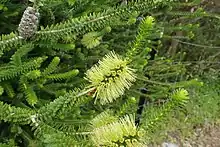Melaleuca diosmifolia
Melaleuca diosmifolia is a plant in the myrtle family, Myrtaceae and is endemic to the south-west of Western Australia. It has also become naturalised in Victoria (Australia) Australia. It is unusual for its genus in that the flowers are green, which partly accounts for its popularity as a garden plant. It is only distantly related to Melaleuca diosmatifolia although its species name has a similar etymology.
| Melaleuca diosmifolia | |
|---|---|
 | |
| Foliage, flowers and fruit of M. diosmifolia | |
| Scientific classification | |
| Kingdom: | Plantae |
| Clade: | Tracheophytes |
| Clade: | Angiosperms |
| Clade: | Eudicots |
| Clade: | Rosids |
| Order: | Myrtales |
| Family: | Myrtaceae |
| Genus: | Melaleuca |
| Species: | M. diosmifolia |
| Binomial name | |
| Melaleuca diosmifolia | |

Description
Melaleuca diosmifolia is a dense shrub sometimes growing to a height of 4 m (10 ft). The leaves are arranged alternately, narrow oval or elliptical in shape, 4–13 mm (0.2–0.5 in) long, 3–5 mm (0.1–0.2 in) wide, crowded close together and lacking a stalk so that the leaf blade attaches directly to the stem.
The flowers are arranged in heads near the ends of branches which continue to grow after flowering and sometimes in the upper leaf axils. There are 25 to 30 individual flowers in each head, the heads up to 50 mm (2.0 in) long and 40 mm (1.6 in) in diameter. The flowers are bright lime-green or pale yellow-green and appear in spring and early summer. The petals are 3.5–4.8 mm (0.1–0.2 in) long and fall off as the flowers age. The stamens are arranged in bundles of five around the flower, with 3 to 5 stamens in each bundle. The fruit are woody capsules up to 8 mm (0.3 in) long and 10 mm (0.39 in) in diameter and form clusters around the stem.[1][2]
Taxonomy and naming
Melaleuca diosmifolia was first formally described in 1807 by Henry Cranke Andrews in The Botanist's Repository for New, and Rare Plants.[3][4] The specific epithet (diosmifolia) is a reference to the similarity of the leaves of this species and those of Diosma.[1]
Distribution and habitat
Melaleuca diosmifolia occurs near the coast of Western Australia between Cape Riche and Albany[2] in the Esperance Plains, Jarrah Forest and Warren biogeographic regions.[5] It grows in shallow, sandy soils in granite outcrops.[6] This species has also become naturalised in the Otway Ranges[2] district of Victoria, where it is considered an environmental weed.[7][8]
Conservation status
Melaleuca diosmifolia is listed as "not threatened" by the Government of Western Australia Department of Parks and Wildlife.[5]
Use in horticulture
This species is well known in cultivation. It is a hardy and adaptable species in most soils and situations except that it will not survive frosts. It can be pruned to make a useful and attractive screen or hedge.[1][9]
References
- Brophy, Joseph J.; Craven, Lyndley A.; Doran, John C. (2013). Melaleucas : their botany, essential oils and uses. Canberra: Australian Centre for International Agricultural Research. p. 150. ISBN 9781922137517.
- Holliday, Ivan (2004). Melaleucas : a field and garden guide (2nd ed.). Frenchs Forest, N.S.W.: Reed New Holland Publishers. pp. 96–97. ISBN 1876334983.
- "Melaleuca diosmifolia". APNI. Retrieved 30 March 2015.
- Andrews, Henry C. (1807). The Botanist's Repository for New, and Rare Plants. 7. p. 98. Retrieved 30 March 2015.
- "Melaleuca diosmifolia". FloraBase. Western Australian Government Department of Parks and Wildlife.
- Paczkowska, Grazyna; Chapman, Alex R. (2000). The Western Australian flora : a descriptive catalogue. Perth: Wildflower Society of Western Australia. p. 393. ISBN 0646402439.
- "Weeds of the surf coast shire". Surf coast shire. Retrieved 30 March 2015.
- "Melaleuca diosmifolia". Queensland government: weeds of Australia. Retrieved 30 March 2015.
- Wrigley, John W.; Fagg, Murray (1983). Australian native plants : a manual for their propagation, cultivation and use in landscaping (2nd ed.). Sydney: Collins. p. 263. ISBN 0002165759.